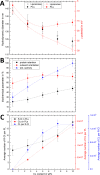Using light scattering to assess how phospholipid-protein interactions affect complex I functionality in liposomes
- PMID: 37292059
- PMCID: PMC10246558
- DOI: 10.1039/d2cb00158f
Using light scattering to assess how phospholipid-protein interactions affect complex I functionality in liposomes
Abstract
Complex I is an essential membrane protein in respiration, oxidising NADH and reducing ubiquinone to contribute to the proton-motive force that powers ATP synthesis. Liposomes provide an attractive platform to investigate complex I in a phospholipid membrane with the native hydrophobic ubiquinone substrate and proton transport across the membrane, but without convoluting contributions from other proteins present in the native mitochondrial inner membrane. Here, we use dynamic and electrophoretic light scattering techniques (DLS and ELS) to show how physical parameters, in particular the zeta potential (ζ-potential), correlate strongly with the biochemical functionality of complex I-containing proteoliposomes. We find that cardiolipin plays a crucial role in the reconstitution and functioning of complex I and that, as a highly charged lipid, it acts as a sensitive reporter on the biochemical competence of proteoliposomes in ELS measurements. We show that the change in ζ-potential between liposomes and proteoliposomes correlates linearly with protein retention and catalytic oxidoreduction activity of complex I. These correlations are dependent on the presence of cardiolipin, but are otherwise independent of the liposome lipid composition. Moreover, changes in the ζ-potential are sensitive to the proton motive force established upon proton pumping by complex I, thereby constituting a complementary technique to established biochemical assays. ELS measurements may thus serve as a more widely useful tool to investigate membrane proteins in lipid systems, especially those that contain charged lipids.
This journal is © The Royal Society of Chemistry.
Conflict of interest statement
There are no conflicts to declare.
Figures






Similar articles
-
Measurements of the proton motive force generated by cytochrome c oxidase from Bacillus subtilis in proteoliposomes and membrane vesicles.Eur J Biochem. 1986 Apr 15;156(2):431-40. doi: 10.1111/j.1432-1033.1986.tb09600.x. Eur J Biochem. 1986. PMID: 3009186
-
The cell-free integration of a polytopic mitochondrial membrane protein into liposomes occurs cotranslationally and in a lipid-dependent manner.PLoS One. 2012;7(9):e46332. doi: 10.1371/journal.pone.0046332. Epub 2012 Sep 25. PLoS One. 2012. PMID: 23050015 Free PMC article.
-
Proton-motive force-driven D-galactose transport in plasma membrane vesicles from the yeast Kluyveromyces marxianus.J Biol Chem. 1991 Jul 5;266(19):12146-51. J Biol Chem. 1991. PMID: 1648083
-
Cardiolipins and biomembrane function.Biochim Biophys Acta. 1992 Mar 26;1113(1):71-133. doi: 10.1016/0304-4157(92)90035-9. Biochim Biophys Acta. 1992. PMID: 1550861 Review.
-
On the role of ubiquinone in the proton translocation mechanism of respiratory complex I.FEBS Lett. 2023 Jan;597(2):224-236. doi: 10.1002/1873-3468.14506. Epub 2022 Oct 9. FEBS Lett. 2023. PMID: 36180980 Review.
Cited by
-
Piperazine-Derived Bisphosphonate-Based Ionizable Lipid Nanoparticles Enhance mRNA Delivery to the Bone Microenvironment.Angew Chem Int Ed Engl. 2025 Jan 15;64(3):e202415389. doi: 10.1002/anie.202415389. Epub 2024 Dec 13. Angew Chem Int Ed Engl. 2025. PMID: 39379320 Free PMC article.
References
-
- Stillwell W., in An Introduction to Biological Membranes, ed. W. Stillwell, Elsevier, 2016, pp. 3–15
-
- Rigaud J.-L. and Lévy D., Membrane Protein Reconstitution, Elsevier, 2003, vol. 372, pp. 65–86 - PubMed
Grants and funding
LinkOut - more resources
Full Text Sources

